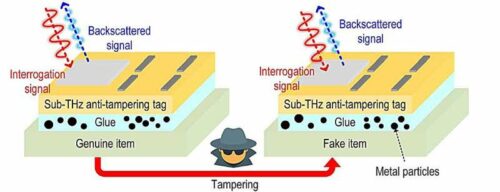- MIT engineers have created a tag that can determine the authenticity of any item.
- The secret lies in the adhesive on the tag’s back.

MIT Researchers have developed a tiny tag that offers improved security over Radio-Frequency IDentification (RFIDs) by utilizing terahertz waves, which are smaller and faster than radio waves. Traditionally, both terahertz tags and RFIDs were vulnerable to counterfeiting, where a tag could be peeled off a genuine item and attached to a fake one without detection by the authentication system. To address this, the researchers mixed microscopic metal particles into the glue that sticks the tag to an object. They then used terahertz waves to detect the unique pattern formed by these particles on the item’s surface. This random glue pattern acts like a fingerprint, authenticating the item.

The researchers produced a light-powered anti-tampering tag that is about 4 square millimeters in size. They also developed a machine-learning model that can detect tampering by identifying similar glue pattern fingerprints with over 99% accuracy. Because the terahertz tag is cheap to produce, it could be implemented throughout a massive supply chain. Its tiny size also enables it to attach to items too small for traditional RFIDs, such as certain medical devices.
The research, a collaboration between MIT’s Terahertz Integrated Electronics Group and the Energy-Efficient Circuits and Systems Group, will be presented at the IEEE Solid State Circuits Conference. It was partly inspired by a car wash’s RFID tag that used fragile paper for added security, which the researchers found unreliable. The authentication system relies on an initial reading of the anti-tampering tag stored in the cloud for verification. Despite limitations, such as the terahertz waves’ high transmission loss and limited range, the researchers are optimistic about the potential of terahertz waves for ID, security, and authentication applications.





